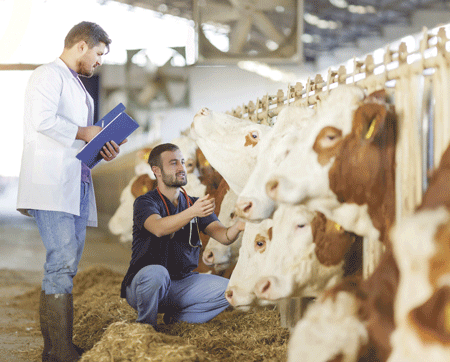 by Tamara Scully
by Tamara Scully
The Pennsylvania Association for Sustainable Agriculture recently hosted a field day, designed to introduce area farmers to the use of forested riparian buffers and other conservation practices. The event was held at Forks Farm Market in Orangeville, PA, an 85 acre diverse livestock farm, located in the Chesapeake Bay watershed. Susan Beal, DVM, ag science advisor and interim farm based education coordinator for PASA, moderated the event, which featured pasture walks, slideshow presentations and group discussions.
Farmers John and Todd Hopkins have been grazing cows on their farm since 1985. After initially running as a cow/calf operation and selling to a sales barn, they realized that making a profit was going to require a change in business planning.
Today, they raise and direct market about 50 head of cattle, 60 hogs, 3500 chicken, several hundred turkey and lambs, all in pastured, rotational grazing systems, both on the home farm, on rented property, and in partnership with other area farmers. The beef and lamb are 100 percent grass-fed, the livestock is pastured year-round, the poultry is out in the fields, free-ranging in large paddocks, and all are moved frequently to fresh pasture, in an intensively managed grazing system which includes silvopasturing practices.
Farming and conservation
Forks Farm is situated on steep terrain, in an area where the high mountains to the north meet the first of the ridge and valley system to their south. The Huntington Creek borders the property to the south, and several tributaries run down the mountainside property. The property is divided into forest and pasture, along with many areas of silvopasture, where the animals and the forest are managed together in a system designed to benefit both.
John Hopkins is a forester by trade, and evaluating forest health is a natural for him. Learning to integrate farming and the forest has been an ongoing process. Over the past decades, he went from grazing the animals with full access to the river and creeks, to fencing them out of the water and implementing a water delivery system to all of his fields, whether they border the water or not.
Before Hopkins could fence the livestock out of the waterways, he needed to have a new watering system in place. Previously, the cows were walking from a hilltop pasture, down a steep, forested hillside, and into a creek to drink. Inevitably, they’d end up hanging out in the shade, not grazing the pasture.
Hopkins began installing his watering system, running 3/4 inch PVC pipe just under the surface, all around the farm. In winter, the pipes were not below the freeze line, so the system could not be used year-round. Eventually, adding a solar-powered pump and water storage tanks provided a solution for winter grazing on some of the remote pastures.
Today, the forested hillside is no longer accessible to the livestock, and water is pumped from a well, up to the mountaintop pastures 168 feet above, via the solar powered irrigation system. A holding tank stores the water, and gravity-fed pipelines carry the water down to the fields.
Kris Ribble, of National Resource Conservation Service (NRCS), assisted Hopkins with the design and implementation of the irrigation system, which is enrolled in the Conservation Reserve Enhancement Program (CREP). CREP provides yearly rental payments, and covers implementation costs to assist farmers with fencing out waterways, implementing watering systems and planting forested riparian buffers.
There are still kinks to be worked on, but the system has allowed the Hopkin’s to better use their land, allowing them better efficiency in their grazing operations. A frost-free hydrant system has been added, and some pressure issues in the watering system are being addressed. NRCS provided compensation for roughly one-half of the system’s cost.
Conservation
Hopkin’s also received assistance from the Chesapeake Bay Foundation, that helped with planning and implementing the farm’s forested riparian buffer areas.
“In Pennsylvania, nature is really trying to go back to being a forest,” Frank Rohrer, of the Cheseapeake Bay Foundation said. A forested area along the river banks is the natural state in Pennsylvania. Forested buffers are more valuable than grass buffers in protecting the waterways, he said, offering more protection from nitrogen pollutants and increasing stream width, decreasing velocity, regulating water temperature and augmenting wildlife habitat.
Rohrer gave a presentation on the implementation of riparian buffers. The proper planting of trees, the selection of the species and ongoing maintenance to promote tree vigor are required. Protecting against girdling by moles is paramount, and proper use of tree shelters provides protection. Weeds and deer must also be managed to promote forested buffer health.
The NRCS riparian buffer requires a primary zone of 15 feet of trees and shrubs, extending from the water to create a stable ecosystem. Another 20 feet of forested area, which sequesters nutrients and captures sediment, is required. Buffers range from this 35 feet width up to 180 feet or more, depending on soil type. Areas outside of the 35 foot forested buffer is planted to forbes and grasses, designed to filter nutrients and sediment. The goal is to establish a forested buffer of 300 woody plants per acre.
Riparian forested buffers filter pesticides and other chemicals, increasing water quality, provide wildlife habitat and biodiversity on the farm. They also stabilize stream banks, preventing erosion.
Keeping the animals dry and clean, particularly for dairy farms, is a benefit. Animals will no longer be susceptible to pollutants from upstream, decreasing illness and increasing biosecurity. Fencing a large field bisected by a waterway can also improve grazing, by creating two smaller paddocks.
Silvopasture
Hopkins has created a forested buffer along the entire section of Huntington Creek bordering his farm. He did not need to plant any new trees to create the buffer: rather he allowed nature a chance to re-establish and enhance tree growth, once the trampling from the livestock was excluded from the bank. He selected trees to maintain, removing undesireable growth. Trees such as native basswood and maples reemerged on their own.
Today, the animals graze in the second zone forested buffer, in a controlled silvopasturing system, as well as in the nutrient-dense forages in the surrounding open pastures. Hopkins uses the forest to provide forage for the livestock, while preventing the livestock from damaging the forest health. He manages the forest canopy to promote forage growth on the forest floor.
The pastures bordering the forested buffer are no-till, and have not been seeded, but feature naturally-occurring forbes and grasses. Twenty-five years ago, when Hopkins began grazing them, they had 2.8 percent organic matter content. Now, they are up above nine percent. These fields have been rotationally grazed by cows and chickens. Hopkins said his pasture acts as a sponge, soaking up water and preventing runoff and erosion because of the way in which it has been managed, complementing and working in conjunction with the forested buffer.
While the animals currently are not fully buffered from one of the tributaries, that will occur once a second well is established, providing this lower pasture with fresh water. The pipe here will be buried to provide water to the pasture during the winter months.
Farmers interested in forested riparian buffers on their land are encouraged to contact their local NRCS office.










Leave A Comment